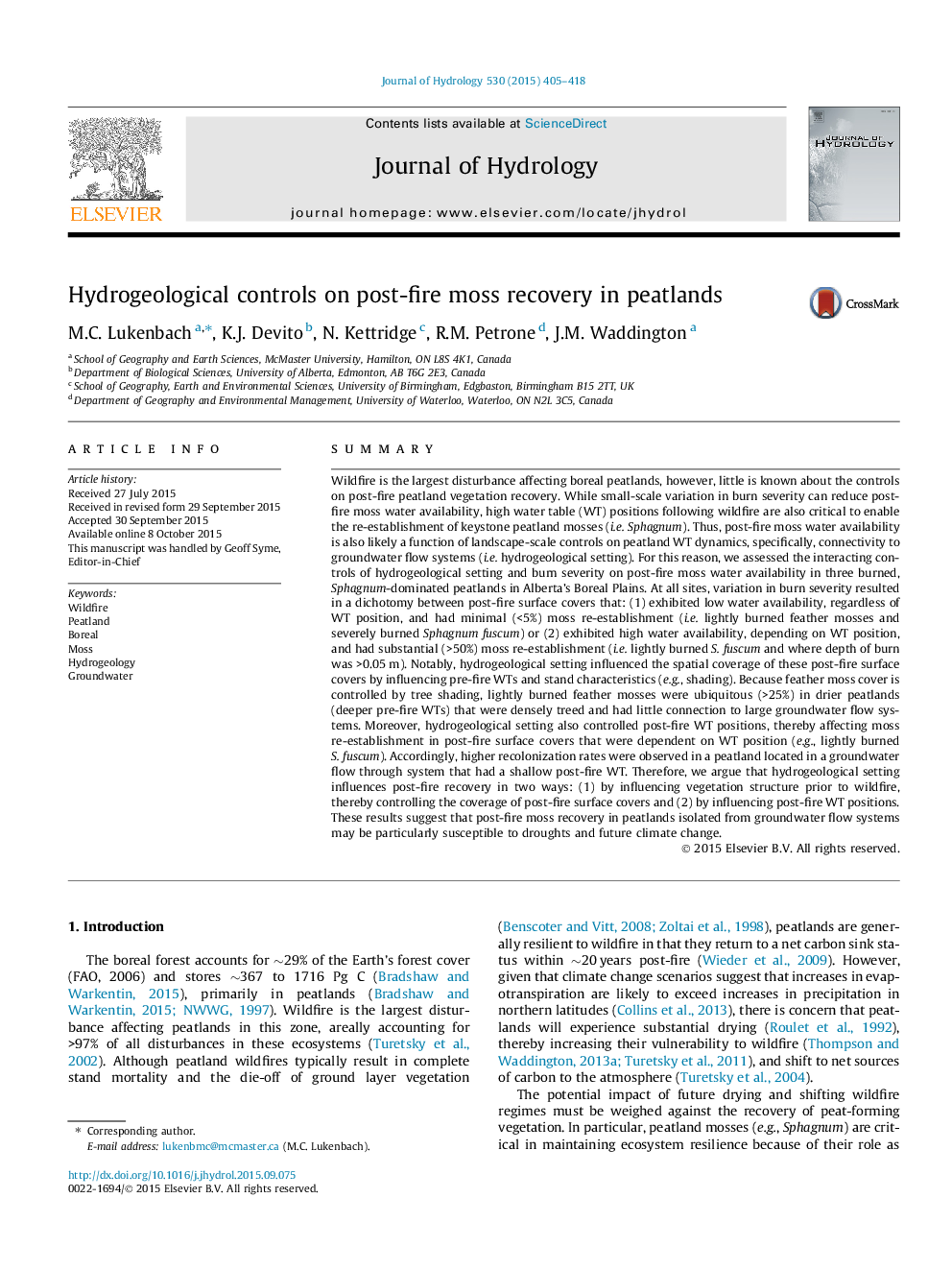| کد مقاله | کد نشریه | سال انتشار | مقاله انگلیسی | نسخه تمام متن |
|---|---|---|---|---|
| 6410216 | 1629921 | 2015 | 14 صفحه PDF | دانلود رایگان |
عنوان انگلیسی مقاله ISI
Hydrogeological controls on post-fire moss recovery in peatlands
ترجمه فارسی عنوان
کنترل های هیدروژئولوژیکی در بازیابی پس از آتش سوزی در سرزمین های شمالی
دانلود مقاله + سفارش ترجمه
دانلود مقاله ISI انگلیسی
رایگان برای ایرانیان
کلمات کلیدی
آتش سوزی، زمین لرزه، بیورال، موش، هیدروژئولوژی، آب های زیرزمینی،
موضوعات مرتبط
مهندسی و علوم پایه
علوم زمین و سیارات
فرآیندهای سطح زمین
چکیده انگلیسی
Wildfire is the largest disturbance affecting boreal peatlands, however, little is known about the controls on post-fire peatland vegetation recovery. While small-scale variation in burn severity can reduce post-fire moss water availability, high water table (WT) positions following wildfire are also critical to enable the re-establishment of keystone peatland mosses (i.e. Sphagnum). Thus, post-fire moss water availability is also likely a function of landscape-scale controls on peatland WT dynamics, specifically, connectivity to groundwater flow systems (i.e. hydrogeological setting). For this reason, we assessed the interacting controls of hydrogeological setting and burn severity on post-fire moss water availability in three burned, Sphagnum-dominated peatlands in Alberta's Boreal Plains. At all sites, variation in burn severity resulted in a dichotomy between post-fire surface covers that: (1) exhibited low water availability, regardless of WT position, and had minimal (<5%) moss re-establishment (i.e. lightly burned feather mosses and severely burned Sphagnum fuscum) or (2) exhibited high water availability, depending on WT position, and had substantial (>50%) moss re-establishment (i.e. lightly burned S. fuscum and where depth of burn was >0.05Â m). Notably, hydrogeological setting influenced the spatial coverage of these post-fire surface covers by influencing pre-fire WTs and stand characteristics (e.g., shading). Because feather moss cover is controlled by tree shading, lightly burned feather mosses were ubiquitous (>25%) in drier peatlands (deeper pre-fire WTs) that were densely treed and had little connection to large groundwater flow systems. Moreover, hydrogeological setting also controlled post-fire WT positions, thereby affecting moss re-establishment in post-fire surface covers that were dependent on WT position (e.g., lightly burned S. fuscum). Accordingly, higher recolonization rates were observed in a peatland located in a groundwater flow through system that had a shallow post-fire WT. Therefore, we argue that hydrogeological setting influences post-fire recovery in two ways: (1) by influencing vegetation structure prior to wildfire, thereby controlling the coverage of post-fire surface covers and (2) by influencing post-fire WT positions. These results suggest that post-fire moss recovery in peatlands isolated from groundwater flow systems may be particularly susceptible to droughts and future climate change.
ناشر
Database: Elsevier - ScienceDirect (ساینس دایرکت)
Journal: Journal of Hydrology - Volume 530, November 2015, Pages 405-418
Journal: Journal of Hydrology - Volume 530, November 2015, Pages 405-418
نویسندگان
M.C. Lukenbach, K.J. Devito, N. Kettridge, R.M. Petrone, J.M. Waddington,
